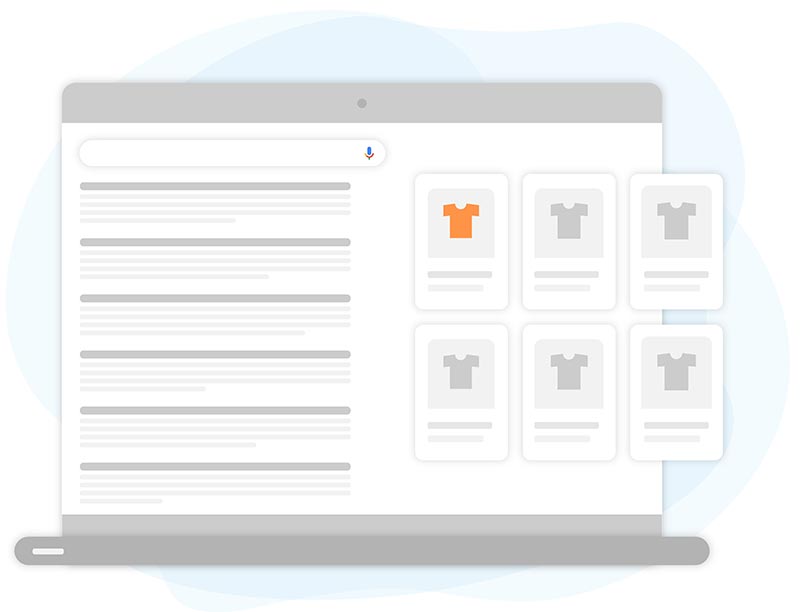

Get monthly notifications
Google Shopping structure – How does it work?
The first thing you should know about Google Shopping is that it’s primarily great for attracting new customers. Returning users will find you in completely different ways – through newsletters, brand searches on Google, or your direct website or webshop.
The possibilities with Google Shopping ads are multiple, and requires wise targeting, multiple campaigns as well as an updated product feed in Google Merchant Center. This is how Google Shopping works!
Google Shopping is best for new users
This aspect is particularly important to understand, since even though new users are always more expensive to attract with Google Ads – you usually accept a lower return if you get valuable customers that will keep returning. If you, through Google Shopping, acquire one single new customer – that will return up to 5-6 times that very same year – this is when you’ll make your real money!
To have better control over which users see your ads, it’s also important to add audience lists that divide your customers into different groups. Analyze the value of your new customers and compare this to your returning ones to know where you should put the most resources. This way, you’ll get the best return from Google – and ultimately better revenue.
Set your target wisely
When using Google Shopping as well as Google Ads, setting your target right is probably the most important thing. Many marketers set their targets too broad and conservatively. If you’re a furniture company, you might sell a new sofa or kitchen table to the same person every 10 years, but if you have a beauty product on your web store, you might easily get 12 purchases from the same user per year. Paying heavily for these customers the first time will soon pay off – and it’s important to see the connection from Google Shopping to lifetime value and your returning, loyal customers.
Find out more about how to leverage customer lifetime value from our webinar!
Multi-brand stores will have to keep an extra eye on their different brands and products, and learn what brand leads to more customer loyalty over time. Customer retention is much better for profits than customer acquisition, since increasing retention rates by as little as 5% can boost profits by 25-95%, according to Bain & Company.
Multiple campaigns are important for the margins
A key mistake that many marketers do when it comes to setting up your Google Shopping is that they tend to have too few campaigns running at the same time. If you have one general budget for all your products, and put them all into the same brand – your revenue will suffer. You might have 5 different margin groups in your products – but if you don’t have the same differentiation in your campaigns, you might have just one targeting option. If you’re a multi-brand retail ecommerce, you must structure your Google Shopping products into multiple campaigns to maintain granularity and get substantial revenue.
Find your negative keywords
Another common mistake is to not use negative keywords in your Google Shopping campaign. Automatically, Google tries to expand where to show your Shopping ads. Which is why you might end up of paying for lots of irrelevant searches and clicks. By using negative keywords, you can exclude these irrelevant hits.
Checklist for setting up a Google Shopping campaign
1. Divide your products into different margin groups
If you have different margins on your products – make sure your campaign matches these. Divide into groups 10-20%, 20-30%, and so on, and set the highest bid on your highest margin.
2. Consider your budget and focus it where it will bring revenue
If you have a limited budget, focus the campaign on your absolutely largest margin group. Start in your key markets, key genders, most profitable age groups, and so forth. What ROI do you actually need to get? Align your goal with the Google Ads setup.
3. Optimize your feed
If you are planning on setting up Google Shopping campaigns – start by optimizing your product feed. Make sure to have the right product, brand, size, model number and/or color in every title, and make other adjustments necessary in the product database Google Merchant Center.
4. Exclude all low performing products
Google Shopping, as Google Ads, is PPC advertising, where you pay per click. If you need at least 50 clicks to sell something, you need to pay the matching amount, for example 50 SEK. If the item in question only is worth 60 SEK – you’ll never get a sufficient ROI on these ads and belonging keywords. Therefore, make sure your campaign contains only the products of value for these keywords.
Featured Articles
The Full Funnel Approach and Pinterest
Today, we're going to delve into the significance of working with a full-funnel strategy and understanding why a comprehensive media mix is crucial. We'll also explore an example of how this approach and including Pinterest in the media mix led to a significant decrease in the cost of sales for Houdini.
Master Text Overlays: Boost Ad Engagement
In recent years, capturing the attention of your target audience has become more challenging than ever. Businesses and marketers are constantly on the lookout for innovative ways to stand out in the crowded advertising landscape.
One effective technique to draw attention to your ad's message is through the use of text overlays on image and video ads. In this blog, we will explore the best practices for incorporating text overlays, ensuring your message is impactful without compromising the visual appeal of your ads.
Similar Articles
Exploring the Future of TikTok: Insights from the 2024 Trend Report
Introduction
I'm excited to delve into TikTok's comprehensive "What's Next 2024 Trend Report." This report is a treasure trove for anyone in digital marketing, offering deep insights into the future of content, storytelling, and consumer engagement on TikTok.
E-Commerce Excellence: Meta's Advantage+ Shopping Campaigns Redefined
Welcome to the dynamic world of e-commerce, where Meta's Advantage+ shopping is reshaping how businesses connect with customers. In this blog post, we'll explore the key features of this innovative tool.
Introducing TikTok Shop
Today, I bring to your attention a revolutionary update from TikTok, a platform where over 150 million Americans seek daily doses of inspiration and entertainment. With a plethora of trends, fashion hacks, beauty nuggets, and a smattering of recipes, TikTok has emerged as a modern-day oracle for curious minds. The excitement in the air thickens as we unveil TikTok Shop to the US, an avant-garde conduit for folks to spot and snag their adored items seamlessly.
The Full Funnel Approach and Pinterest
Today, we're going to delve into the significance of working with a full-funnel strategy and understanding why a comprehensive media mix is crucial. We'll also explore an example of how this approach and including Pinterest in the media mix led to a significant decrease in the cost of sales for Houdini.
Master Text Overlays: Boost Ad Engagement
In recent years, capturing the attention of your target audience has become more challenging than ever. Businesses and marketers are constantly on the lookout for innovative ways to stand out in the crowded advertising landscape.
One effective technique to draw attention to your ad's message is through the use of text overlays on image and video ads. In this blog, we will explore the best practices for incorporating text overlays, ensuring your message is impactful without compromising the visual appeal of your ads.
The Next Big Thing: 5 Digital Marketing Trends to Watch for in 2023
Digital marketing is a constantly evolving field, shaped by emerging technologies, changing consumer behaviors, and the dynamic nature of the online landscape. Staying on top of the latest trends is crucial for businesses and marketers to effectively engage with their target audience and drive growth. In this introduction, we will explore some of the key digital marketing trends that have emerged in recent times.
The Power of Branding on Meta
Are you ready to unlock unparalleled opportunities and take your online business to new heights? In a rapidly evolving digital landscape, Meta continues to revolutionize the way marketers and entrepreneurs create an impact on buyers.
Today, we will talk about the immense potential of branding on Meta's platforms, Facebook and Instagram based on our Meta Branding (Online Course). Brace yourself for insights that will empower you to establish a strong brand identity, harness consumer trends, and optimize your advertising strategies like never before! Ready to spearhead your business to success? by understanding the potential of branding on Meta and how you can tap into it. Excited? So are we - let's get into it!
A Sneak Peek into Pinterest's 2023 Product Updates!
Pinterest is improving its Ads Manager to provide a seamless experience for advertisers. New features will be released throughout 2023 to optimize advertising strategies. Pinterest aims to offer powerful tools and insights for better campaign results. Get a sneak peek into the exciting updates coming to Ads Manager this year.
Take Your TikTok Ads to the Next Level
To look into the future, let us peep into the past once. TikTok was once loaded with content focused on dancing and lip-syncing videos inclined more towards an uprising for polished platforms and enabling easy access and non-positionality of content largely consisting of short videos.